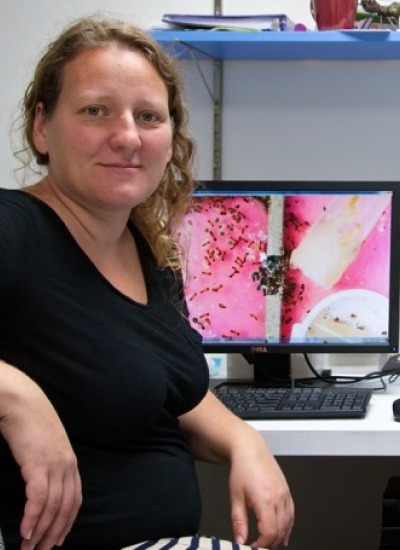Anna R Dornhaus
Publications
Abstract:
Social insects are well-known for their ability to achieve robust collective behaviours even when individuals have limited information. It is often assumed that such behaviours rely on very large group sizes, but many insect colonies start out with only a few workers. Here we investigate the influence of colony size on collective decision-making in the house-hunting of the ant Temnothorax albipennis. In experiments where colony size was manipulated by splitting colonies, we show that worker number has an influence on the speed with which colonies discover new nest sites, but not on the time needed to make a decision (achieve a quorum threshold) or total emigration time. This occurred because split colonies adopted a lower quorum threshold, in fact they adopted the same threshold in proportion to their size as full-size colonies. This indicates that ants may be measuring relative quorum, i.e. population in the new nest relative to that of the old nest, rather than the absolute number. Experimentally reduced colonies also seemed to gain more from experience through repeated emigrations, as they could then reduce nest discovery times to those of larger colonies. In colonies of different sizes collected from the field, total emigration time was also not correlated with colony size. However, quorum threshold was not correlated with colony size, meaning that individuals in larger colonies adopted relatively lower quorum thresholds. Since this is a different result to that from size-manipulated colonies, it strongly suggests that the differences between natural small and large colonies were not caused by worker number alone. Individual ants may have adjusted their behaviour to their colony's size, or other factors may correlate with colony size in the field. Our study thus shows the importance of experimentally manipulating colony size if the effect of worker number on the emergence of collective behaviour is to be studied. © Birkhäuser Verlag, 2006.
Abstract:
Although models of colony organization in social insects often rely on the assumption that within-group variation increases group performance, empirical support for this is mostly confined to studies of genetic variation. However, workers in ant or bee colonies often vary in behaviour and morphology even when genetic variation is low. Bumblebees provide a unique opportunity to explore the consequences of such variation: colonies have a wide range of worker body sizes compared to other social bee species, and workers also vary in response thresholds (i.e. stimulus levels at which workers respond by performing a task), in spite of queens being singly mated (and thus, low genetic variation). Here we test how body size and response threshold diversity affect colony performance in two unrelated in-nest tasks (thermoregulation and undertaking). We manipulated worker diversity using worker removals to restrict threshold or body size variation within the colony. We also quantified the degree of intracolony variation across colonies and related this to colony performance. In general, colonies took longer to cool the nest after bees were removed, but there was no significant effect of treatment on fanning or undertaking success. Furthermore, when intracolony variation was analysed as a continuous variable, we found no effect on colony-level thermoregulation or undertaking performance. Instead, average threshold was a more useful predictor of thermoregulation success, and colonies with a narrower range of size variation had more success at undertaking. These results emphasize the importance of understanding how different types of variation (e.g. behavioural, morphological, etc.) contribute to colony performance. © 2013 The Association for the Study of Animal Behaviour.
Social insects display task-related division of labour. In some species, division of labour is related to differences in body size, and worker caste members display morphological adaptations suited for particular tasks. Bumble-bee workers (Bombus spp.) can vary in mass by eight- to tenfold within a single colony, which previous work has linked to division of labour. However, little is known about the proximate mechanism behind the production of this wide range of size variation within the worker caste. Here, we quantify the larval feeding in Bombus impatiens in different nest zones of increasing distance from the centre. There was a significant difference in the number of feedings per larva across zones, with a significant decrease in feeding rates as one moved outwards from the centre of the nest. Likewise, the diameter of the pupae in the peripheral zones was significantly smaller than that of pupae in the centre. Therefore, we conclude that the differential feeding of larvae within a nest, which leads to the size variation within the worker caste, is based on the location of brood clumps. Our work is consistent with the hypothesis that some larvae are 'forgotten', providing a possible first mechanism for the creation of size polymorphism in B. impatiens.
Abstract:
The honey bee dance language, used to recruit nestmates to food sources, is regarded by many as one of the most intriguing communication systems in animals. What were the ecological circumstances that favoured its evolution? We examined this question by creating experimental phenotypes in which the location information of the dances was obscured. Surprisingly, in two temperate habitats, these colonies performed only insignificantly worse than colonies which were able to communicate normally. However, foraging efficiency was substantially impaired in an Asian tropical forest following this manipulation. This indicates that dance language communication about food source locations may be important in some habitats, but not in others. Combining published data and our own, we assessed the clustering of bee forage sites in a variety of habitats by evaluating the bees' dances. We found that the indicated sites are more clustered in tropical than in temperate habitats. This supports the hypothesis that in the context of foraging, the dance language is an adaptation to the particular habitats in which the honey bees evolved. We discuss our findings in relation to spatial aggregation patterns of floral food in temperate and tropical habitats.


